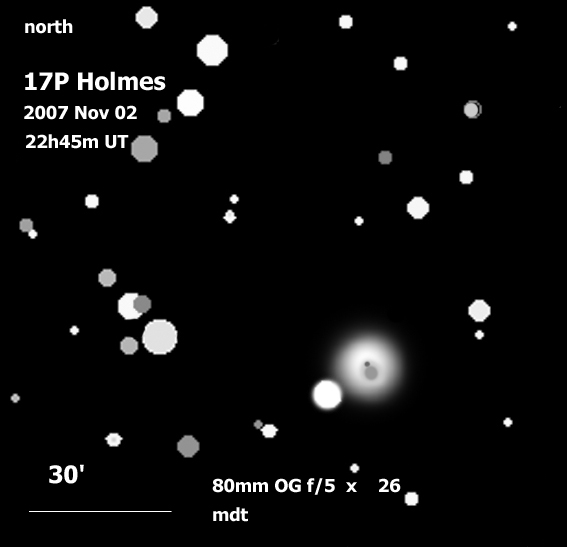17P/Holmes
Comet yr/m/d(UT)
method mag. ref. ap(cm) type magn. diam. dc tail obsr.
17P/ 071027.77 S 2.1 TT 7 B 16 5.9 - - M.D.Taylor
17P/ 071027.77 S 2.5 TT 2.5 B 8 3.8 - - M.D.Taylor
17P/ 071028.95 - - - 8 R 26 6.6 - - M.D.Taylor.1
17P/ 071029.74 S 3.0 TT - NE - - - - M.D.Taylor
17P/ 071029.74 - - - 7 B 16 8.4 - - M.D.Taylor
17P/ 071102.05 S 3.0 TT - NE - - - - M.D.Taylor
17P/ 071102.05 - - - 7 B 16 15.6 - - M.D.Taylor
17P/ 071102.94 - - - 8 R 26 18.7 - - M.D.Taylor.2
17P/ 071105.90 S 3.0 TT 2.5 B 8 20.0 3 - M.D.Taylor
17P/ 071105.96 - - - 8 R 26 13.2 5 - M.D.Taylor.3
17P/ 071107.80 - - - 7 B 16 18.6 4 - M.D.Taylor.4
17P/ 071107.85 - 2.9 TT 2.5 B 8 19.6 3 - M.D.Taylor
17P/ 071108.96 S 3.0 TT 2.5 B 8 21.2 3 - M.D.Taylor
17P/ 071111.85 - - - 7 B 16 28x25 4 - M.D.Taylor.5
17P/ 071111.85 S 3.2 TT 2.5 B 8 23.8 2 - M.D.Taylor
notes: S = Sidgwick method of total mag. but for NE obs this is probably not valid
TT = Tycho V mags
B = mounted 16x70 binoc or hand-held 8x25 roof prism type
NE = naked eye
diam = coma diam. arc mins.
R = 80mm f/5 refra + star diag. x 26 magn.
1: stars seen thru' oblate coma
2: 071102.94 again there is a star near the brightest part of the inner regions,
mag. 9(?) and the internal elongated coma axis lies to PA 190*.
3: s. edge of comet appears flattened (non circular),mag. 10 stars near ext. coma.
4: shape of coma is oblate, flattened with major axis to PA 190*.
(A probable, spurious observation with 16x70B suggested a long curving tail to PA
280* )
5: The coma is distinct oblate and the size was measured from a drawing via Millennium star atlas. The inner cd is elongated with its axis to PA 193*.
MDT, Wakefield, West Yorkshire, UK. [2007 Nov 12]
|

Page last updated: Sun 2 Apr 07:59:06 BST 2023